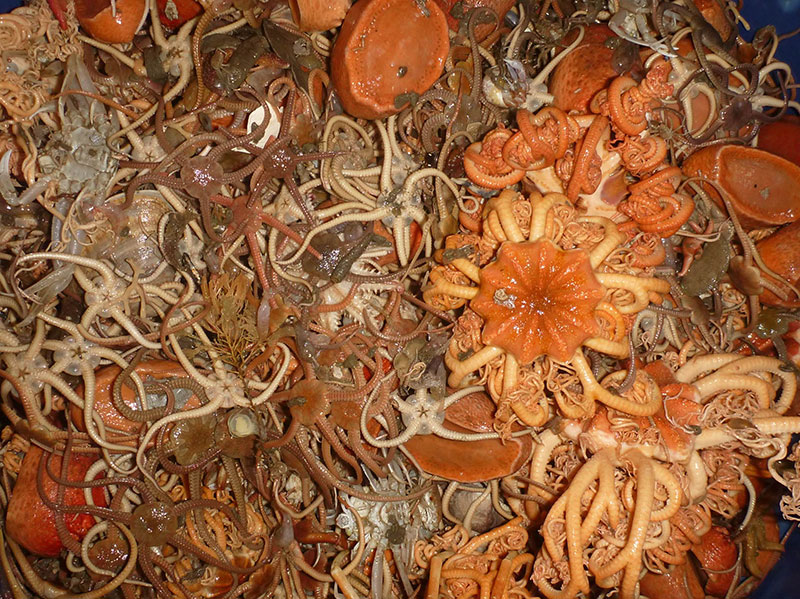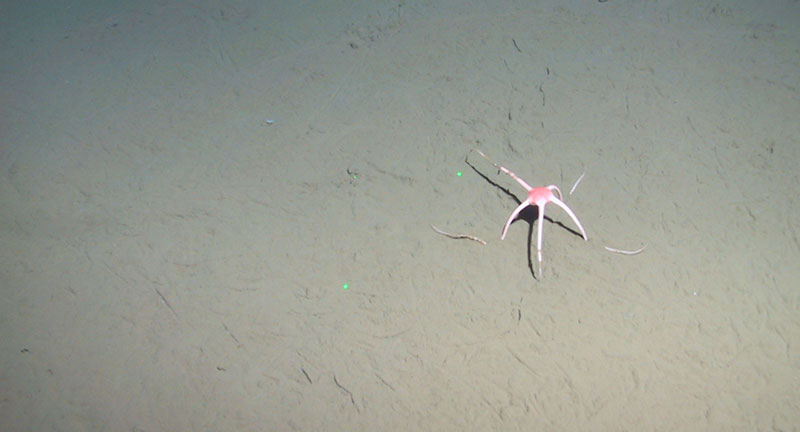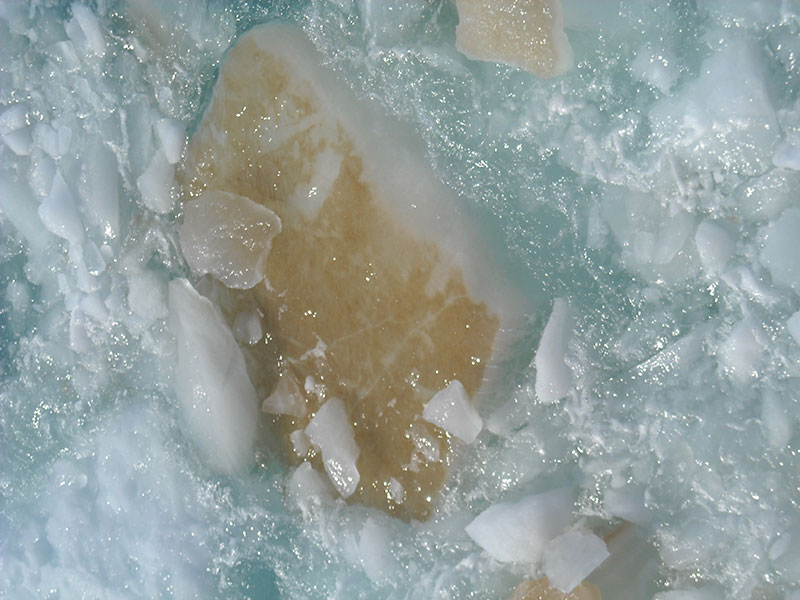
by Katrin Iken, Professor in Marine Biology, School of Fisheries and Ocean Sciences, University of Alaska Fairbanks

A trawl catch of the rich benthic fauna on the Arctic shelf at 50 meters depth showing lots of brittle stars, feather stars, and sea cucumbers. Image courtesy of Katrin Iken, University of Alaska Fairbanks. Download larger version (1.6 MB).
Contrary to what one might expect in an ice-covered ocean, the seafloor of the Arctic Ocean is actually teeming with life. These seafloor animals are called “benthos.” The most abundant types of benthos we find are brittle stars, sea cucumbers, sea stars, snails, clams, bristle worms, and, occasionally, crabs.
One of the reasons that there is so much benthic life in the Arctic is that much of the primary production from microscopic algae under the ice and in the water column sinks to the seafloor rather than being consumed by plankton, the small organisms living suspended in the water column. The plankton animals, for the most part, go into a resting stage (diapause) over winter and have not reached significant numbers and high metabolic rates yet when the early spring primary production occurs. Therefore, a lot of this early food source sinks to the seafloor instead of being consumed in the water column and provides nutrition to a rich benthic community.
In addition, these seafloor animals are very good at feeding on any organic matter within the soft sediment of the Arctic seafloor, even if this matter is not so fresh and “yummy” any more. Examples of such material are fecal pellets from the plankton or decaying dead animal parts. This allows benthic organisms to subsist and even thrive in an environment that is limited in new food over long periods of time (e.g., during winter).

A sole brittle star making its way across the Arctic deep-sea plain at 3,000 meters depth. Image courtesy of Katrin Iken, University of Alaska Fairbanks. Download larger version (1.2 MB).
Arctic benthic animals have also adapted to the permanently low temperatures. Some body functions, such as respiration and reproduction, work at slower rates than in animals in warmer waters. This does not mean that Arctic benthos do not do as well as organisms from warmer waters, but rather that these animals function best at ambient low temperatures. As a consequence of the slow 'rate of living,' Arctic animals tend to grow very slowly and many tend to live for decades.
The diversity of the benthos can be very high, and it typically declines with depth, from the continental shelf parts at about 50 meters depth to the deep seafloor at about 5,000 meters depth. On the shelves, we often find species that immigrate from the Pacific or Atlantic Oceans in to the neighboring Arctic shelves, but their influence lessens the deeper we go and the more “arctic” the environment becomes. Most interestingly though, we do find many more species that have an Atlantic Ocean origin in the Arctic deep sea, even in locations in the western Arctic close to the Pacific Ocean, rather than deep-water Pacific species. The reason for this is that the only connection between the Pacific and the Arctic Ocean is the Bering Strait, which is very shallow (maximum 50 meters) and thus does not allow any Pacific deepwater fauna to enter the Arctic. In contrast, there has been a deepwater connection to the Atlantic throughout the history of the Arctic, so that species from the deep Atlantic could migrate into the Arctic when conditions are right.

Microscopically small algae grow on the bottom of a piece of overturned Arctic sea ice. This algae would go away if there is no longer any sea ice during the Arctic summer, impacting the entire Arctic food web. Image courtesy of Katrin Iken, University of Alaska Fairbanks. Download larger version (2.1 MB).
We expect the benthos in the Chukchi Borderland region to be especially interesting. For one, the region ranges over a great bathymetric extent—we expect sampling between 300 and 3,000 meters of water depth! This should contribute greatly to our understanding of depth-related patterns in seafloor communities.
The Chukchi Borderland region is also topographically complex and has a number of ridges, canyons, and large depressions (on the order of hundreds of meters wide) from extinct seep activities, all of which provide unique habitat for benthic organisms. This is likely to increase the benthic diversity, and we believe that there is a very high chance that we will find new, undescribed species. Using a remotely operated vehicle will allow us to associate these animals with such seafloor structures to better understand their habitat requirements.
Lastly, the Chukchi Borderland is a region where Arctic, Pacific, and Atlantic water masses mix in complex fashion, influencing the biogeography (origin) of the species occurring there. The Atlantic water mass experienced significant warming over the last two decades, and the Pacific water has become considerably fresher (less salty), both of which are climate change effects that are highly relevant for the seafloor animals in the region.